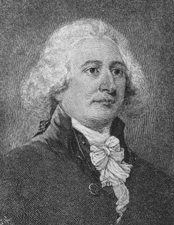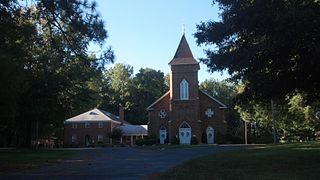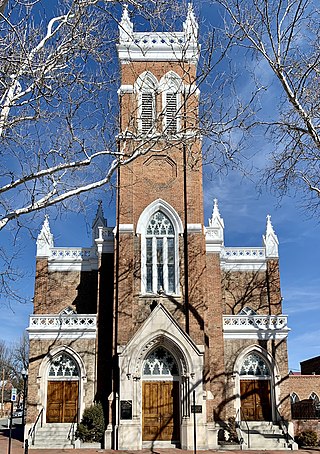
John Brown was an American lawyer and statesman who participated in the development and formation of the State of Kentucky after the American Revolutionary War.

Penfield, Georgia, United States was established shortly after 1829 in Greene County, and named in honor of Josiah Penfield, a Savannah merchant and silversmith from Fairfield, Connecticut, who bequeathed $2,500.00 and a financial challenge to the Georgia Baptist Convention to match his gift for educational purposes. The convention, led by Billington Sanders, organized a manual labor school which opened in 1833 as Mercer Institute, in honor of Rev. Jesse Mercer of Greene County, a major contributor to the matching gift request.
Denver, formerly known as Dry Pond, is a census-designated place and unincorporated community in Lincoln County, North Carolina, United States. As of the 2010 census it had a population of 2,309.

Livingston Mims was an American politician who served as the 37th mayor of Atlanta, Georgia during the early 20th century.

Johns Island is an island in Charleston County, South Carolina, United States, and is the largest island in the state of South Carolina. Johns Island is bordered by the Wadmalaw, Seabrook, Kiawah, Edisto, Folly, and James islands; the Stono and Kiawah rivers separate Johns Island from its border islands. It is the fourth-largest island on the US east coast, surpassed only by Long Island, Mount Desert Island and Martha's Vineyard. Johns Island is 84 square miles (220 km2) in area, with a population of 21,500.
Rev. John Brown was the third president of the University of Georgia. He served in that capacity from 1811 until his resignation in 1816.

The Old Scotch Church, also known as the Tualatin Plains Presbyterian Church, is a church and national historic site located in an unincorporated part of Washington County, Oregon, near Hillsboro, Oregon, United States. The church dates to 1873 while the church structure with an eight-sided steeple dates to 1878. A cemetery on the church grounds holds the graves of church members and local pioneer settlers of the Tualatin Plains, including Joseph Meek.

The Presbyterian Church in Westfield, New Jersey was established in 1728, when twelve to eighteen of the early settlers built a log house for worship near what is now Benson Place.

Monroe Township is one of ten townships in Jefferson County, Indiana, United States. As of the 2010 census, its population was 374 and it contained 176 housing units.
Darby and Tarlton were an American early country music duo, who achieved some level of success in the late 1920s. The duo consisted of Tom Darby and Jimmie Tarlton,.

Stephen Bloomer Balch was a Presbyterian minister and educator in Georgetown, which is now part of Washington, D.C. In 1780, Balch established Georgetown Presbyterian Church, which was the second church in Georgetown. He also served as headmaster of the Columbian Academy in Georgetown.

The Middle Spring Presbyterian Church was built in the Province of Pennsylvania in 1738 by early Scotch Irish settlers. It has been mentioned frequently in the histories of the early days of Cumberland County, Pennsylvania and of the Commonwealth of Pennsylvania, in general.

The Second Rindge Meetinghouse, Horsesheds and Cemetery is a historic meeting house and cemetery on Old US 202 and Rindge Common in Rindge, New Hampshire. Built in 1796, it is relatively distinctive in New England as one of few such meeting houses where both civic and religious functions are still accommodated, housing both the town offices and a church congregation. The town's first cemetery, established in 1764, lies to the north of the meetinghouse. It is the resting place of many of Rindge's early settlers, and of its American Revolutionary War veterans. Behind the meetinghouse stand a row of horse sheds, the only one of the two rows of them which originally served the meetinghouse. The property was listed on the National Register of Historic Places in 1979.

The Hartford Baptist Church is located on Main Street in Hartford, New York, United States. It is a brick church with tall wooden bell tower built in the late 19th century on the same site as the congregation's original 1789 church on land deeded to it by Dewitt Clinton, the fourth of its churches to occupy the site. Designed by Philadelphia architect Benjamin Price, it is the only Victorian Gothic church in the town, and one of a few in the county. Next to the church is a cemetery with almost two centuries of graves, including those of early Hartford settlers and some Revolutionary War veterans.

Carter-Newton-Glover House at 530 Academy Street, Madison, Georgia, is one of the grand homes of Madison built during its heyday, 1840–60, leading up to the Civil War. A classic four-over-four Greek Revival home, one of six of this type in Madison, it features a wide front porch supported by four large scamozi fluted columns, eight 20' × 20' rooms plus three additional ones in back, 12½ foot ceilings downstairs, and nine fireplaces upstairs and down. The central structure seems largely unchanged from when it was constructed but in fact has undergone a number of alterations. Of special significance are the very impressive entrance hall, double parlors and the main and servants’ staircases. Pocket doors to the main parlors, added in 1902, still operate. The house sits on 1.04 acres (4,200 m2), with six adjoining undeveloped acres to the rear; the view out the back vestibule is of a lovely rural scene.
Alpine Community Church, originally known as Alpine Presbyterian Church, was built in 1853. It is located on Highway 337 in Menlo, Georgia.

Thyatira Presbyterian Church, Cemetery, and Manse is a historic church at 220 White Road off NC 150 in Mill Bridge in Rowan County, North Carolina, ten miles west of the town of Salisbury. Presbyterians have been worshiping at this site since at least 1753.

Christ Church, or Christ Episcopal Church, is an Anglican church in Winchester, Frederick County, Virginia. The church was founded in 1738, with its first vestry elected in 1742. It is the seat of Frederick Parish, Diocese of Virginia, which once covered half of the Shenandoah valley and western Virginia, including what became West Virginia. The current church building, the parish's third, was designed by Robert Mills - it was completed in 1828, and is the oldest church building continuously used for religious purposes in the county. It is a contributing building in the local Historic District which predates the National Register of Historic Places, and which has been expanded three times since 1980.
Thomas Gillespie was a large plantation owner in mid-to-late 18th-century North Carolina and served as commissary of the Rowan County Regiment in the North Carolina militia during the American Revolution. He spent his early life in Augusta County, Virginia before migrating to Anson County, North Carolina in about 1750, where he lived most of his life on Sills Creek in the area that became Rowan County, North Carolina in 1753. He and his wife and son were the first white settlers west of the Yadkin River. He owned a plantation of over 1,000 acres on Sills Creek in Rowan County, as well as 6,000 acres in the area of western North Carolina that became part of the state of Tennessee in 1796. He was an early elder in the Thyatira Presbyterian Church in Rowan County, which had been established by 1750. Thomas was the great-grandfather of U.S. President James K. Polk through the lineage of his daughter Lydia, who married Captain James Knox and gave birth to Jane Gracey Knox, mother of the President.

Missouri H. Stokes was an American social reformer and writer of the long nineteenth century associated with the temperance movement. While working in the missionary field and having charge of the Mission Day School in Atlanta, she found herself drawn into the crusade for temperance after it expanded into the South. In 1880, Stokes became a member of the Atlanta Woman's Christian Temperance Union (WCTU), the first local Union organized in Georgia. In 1881, she became its secretary, and when the State WCTU was organized in 1883, she was appointed State Corresponding Secretary, holding both offices until her resignation in 1893. For years, she was the Georgia Special Correspondent of The Union Signal, and for various papers in her own State, she furnished temperance articles. Stokes was one of the Georgia women to whose efforts the State was largely indebted for the passage of its General Local Option Law and also for its Scientific Instruction in the Public Schools, thousands of petitions for both these measures being sent by Stokes through the post office.

















